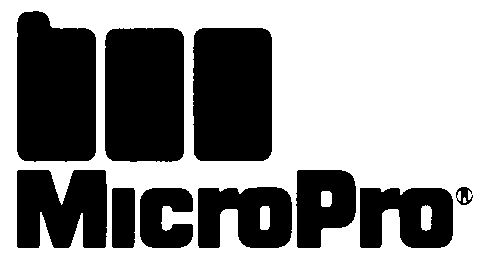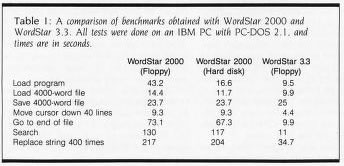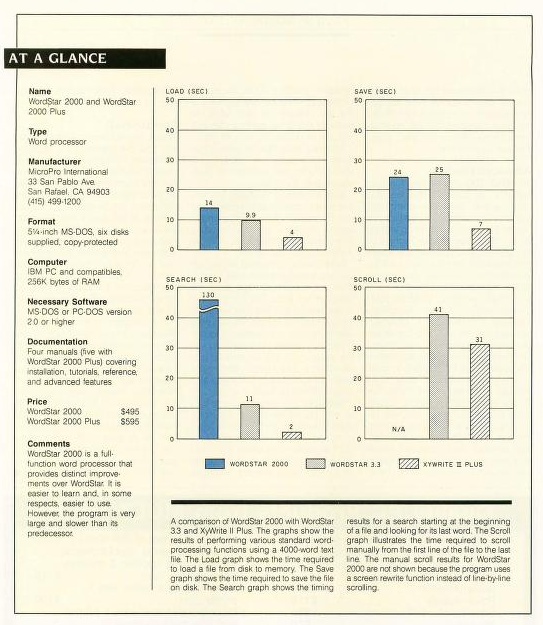 WordStar 2000 Review
WordStar 2000 Review
BYTE Magazine, September 1985
WordStar's first offspring is easy to use but somewhat slow
BY Malcolm C. Rubel
Although WordStar was not the first word processor for microcomputers and some people argue that it is not the best, it is certainly the most successful. While hundreds of users wrote patches to help the program do more than it already could, the publisher of the pack- age made few changes or improvements until now.
In response to a large number of com- petitors who claim that their word pro- cessors are easier to learn and use, Micro- Pro has released WordStar 2000 for the IBM PC and compatibles.
The new WordStar 2000 is available in the basic version and as WordStar 2000 Plus. The basic version contains MicroPro's spell- ing checker, CorrectStar, and retails for $495. The Plus version includes MailMerge, Starlndex, and a new feature, TelMerge. WordStar 2000 Plus retails for $595.
MicroPro has gone to considerable lengths to eliminate the difficulties that new users have encountered with WordStar. The product includes a new training guide of over 200 pages and a guide to the pro- gram's advanced features (it's 217 pages and included with WordStar 2000 Plus) giv- ing further lessons for TelMerge, MailMerge, and Starlndex. Also included is a new series of interactive disk tutorials that will provide basic information for beginners.
WordStar 2000 is easier to learn than the original WordStar. For those with WordStar experience, the program will look familiar but the keystrokes will be different. Micro- Pro still uses control-key sequences to in- voke commands, but these sequences have been changed to resemble the command a bit more closely. For example. Ctrl-C gives the choices for moving the cursor, Ctrl-P brings up print enhancements, and Ctrl-L is for locate. WordStar 2000 also uses Ctrl-G to call up context-sensitive help virtually anywhere in the program (Ctrl-H is the back- space code, not the help code).
MicroPro has also assigned many more commonly used commands to the function
keys (shifted and unshifted) and to the number keys at the top of the keyboard combined with Alt. The assignments made by MicroPro include some infrequently used commands such as Merge: Select Data File and Merge: Next Copy but leave out such commonly used commands as Locate and Remove Block.
MicroPro lets you change the commands on the function and number keys in its in- stallation program, but all the reference aids that the company provides have the basic assignments etched in plastic. When you make changes, the cards become much less useful.
Those commands in WordStar that were somewhat unusual have been straightened out and are easier to remember. Dot com- mands and format changes are no longer necessary WordStar 2000 contains pre- determined format lists that provide all the basic setups for the user You simply specify which one you want to use when you create your document, and that format will be used each time you work with that file. You can also create your own format files.
Most of this is great, but what's the catch? Unfortunately WordStar 2000 executes more slowly than its predecessor and, in some instances, has become less easy to use because it's become easier to learn.
Starting Up
WordStar 2000 requires version 2.0 or higher of MS-DOS or PC-DOS, two disk drives, and a minimum of 256K bytes of RAM (random-access read/write memory). More RAM can be assigned to buffers in the CONFIG.SYS file and speeds up execution considerably Like WordStar the new pro- gram makes heavy use of overlays.
The opening menu now takes up two screens; the user can toggle between them by using the space bar WordStar's basic ap- proach is still there but MicroPro has spread out the menu so individual entries are easier to see. You activate menu choices by typing a one-key mnemonic.
lb edit a document, you strike E and either type in the filename or move the cursor to it. if you are creating a new document, you are also asked which format file to use. As mentioned earlier, the format comes up with the file each time you call it, sav- ing the initial formatting that was nec- essary with WordStar.
TEXT Entry
Once you choose the format, you are presented with the editing screen. The menu of the basic editing options takes up the top half of the screen, but you can set the program so only the submenus show after you strike the initial menu key or so that no menu shows at all.
 Those familiar with WordStar will feel at home with the editing screen; it looks the same. Tabbing, which is set every n spaces in the format files, can be reset as you wish. Decimal tab- bing is available with a choice of U.S. or European decimal points. You move the cursor either with the cur- sor keys or by using the traditional WordStar control-key cursor "dia- mond." You activate large cursor moves by using the Ctrl-C submenu of commands. The commands mirror those available with WordStar
Those familiar with WordStar will feel at home with the editing screen; it looks the same. Tabbing, which is set every n spaces in the format files, can be reset as you wish. Decimal tab- bing is available with a choice of U.S. or European decimal points. You move the cursor either with the cur- sor keys or by using the traditional WordStar control-key cursor "dia- mond." You activate large cursor moves by using the Ctrl-C submenu of commands. The commands mirror those available with WordStar
Unfortunately moving through a WordStar 2000 file can be a slow pro- cess. In all comparative tests, I found a substantial reduction in perfor- mance. The most serious prololem is the screen-rewrite time. It is so slow that when you hold the down-arrow key to scroll through the file, the
display goes blank as you move off the current screen. You must release the key for a few seconds to let the screen rewrite. In all cases, WordStar 2000's times were slower than Word- Star's, even with a hard disk.
Text Editing
You can delete text using the back- space key for delete left or the delete key for delete right. I found it unusual that the delete left command is an overlay; i.e., it is not always in memory The first time you use it, the program has to load the code for this com- mand from drive A. That process takes more than a second, larger deletions, such as delete word, sen- tence, paragraph, etc., are included in the Ctrl-R (Remove) menu. The pro- gram also has an Undo command (Ctd-U) that makes this function a powerful cut-and-paste option.
Block operations perform smoothly Blocks can be either horizontal for normal text or vertical for tables. WordStar 2000 has also provided for block sorting (either numerically or alphabetically in ascending or de- scending order) for blocks up to 1 50 entries and block arithmetic (horizon- tally and vertically).
One feature most people will like about WordStar 2000 is its dynamic justification. As you insert and delete text, the paragraph remains justified, and if you change your margins, text will automatically be reformatted to your new margin settings. However, the reformatting is not instantaneous. If you reset the margins and then try to page through your file using the
PgDn key the time it takes to write a new screen of text increases from 2.6 seconds to 6 or 7 seconds.
A second feature that will be useful ■ to some users is the program's win- dowing capabilities. WordStar 2000 will open up three different windows to look at three different files. You can shift text from one file to another, making document assembly much easier Window sizes are predeter- mined and cannot be changed.
Search and Replace operations are now included in a single command, Ctrl-L (for Locate). Tb search, you enter the string and strike several car- riage returns to invoke. To replace text, you type R after entering the search string and then, when prompted, type in the replacement string. A large number of options are available, including whole-word search, case sensitivity and wild cards. Unfortunately the speed at which WordStar 2000 performs these operations is quite slow even with a hard-disk system. See the times in table 1.

Formatting and Printing
WordStar 2000 provides for multiple- line headers and footers that you can alternate for right- and left-facing pages, separate print offset settings for right- and left-facing pages, flexi- ble page-number placements, any number of different line lengths and tab settings in a document, and justi- fied and nonjustified text included in a single file. You indicate line spacing by selecting different line heights. They allow for single, double, and tri- ple spacing, as well as eight lines to an inch, but do not have the number of choices that were available with the WordStar Line-height command.
WordStar 2000 has improved Word- Star's Hyphen-help function. The pro- gram has a function that will automat- ically insert hyphens where necessary as part of the dynamic justification process. Text looks better when you use the function. It works well, but 1 wish that IVlicroPro had given me the chance to define the decision criteria for applying hyphenation. The algo- rithm is not accessible to the user
WordStar 2000 supports everything from typewriter conversions to the HP LaserJet. It prints proportionally if the feature is supported on your printer, but instead of adding microspaces be- tween the characters when perform- ing right justification on my test printer (NEC 3 5 50), it added micro- spaces between the words. Interchar- acter microspacing gives a finished document a better look.
WordStar 2000 supports chain and nested printing but, unlike WordStar 3.3, does not do background printing. WordStar 2000 has a function called Print and Resume Editing that prints a copy of the file to disk and then goes back to the opening menu. With a file of any size, the time you spend waiting is considerable. BYTE's
4000-word benchmark test file took 199 seconds to format on a floppy system and 168 seconds on a hard- disk system before bringing me back to the opening menu. You must also make sure you have enough space on your logged disk drive to accom- modate the temporary print files because they take up more space .
than the document file does. If the logged drive does not have enough space, you will be presented with the message: "An unrecoverable error oc- curred while printing (filespec). Press ESCape to continue."
Advanced Features
WordStar 2000 has a new function called a key directory that lets you store either word or command macros in any number of files that you desire. They are easy to set up and ex- ecute. You type in the command string under which the macro is stored and press Esc, and the macro will be executed. For repetitive procedures, this is a godsend.
The basic version of WordStar 2000 comes with CorrectStar, MicroPro's spelling checker. The program seemed to work well. You can create personal dictionaries to supplement the basic dictionary This program is also slow, taking 305 seconds to make a single pass with no corrections through a 5000-word test file on the floppy system. When making correc- tions, CorrectStar ran even slower, re- quiring 17 to 30 seconds to read through 1 to 1 7 lines of text and high- light a mistake. Performance on a hard disk was not much better, although you do avoid changing disks. Unfortunately WordStar 2000, like earlier versions of WordStar changes bit 8 of the last character in each word, so many of the other spelling checkers will not work directly with its files.
WordStar 2000 Plus includes some- thing completely new, Tfeliy/Ierge. It also includes new versions of Mail- Merge and Starlndex.
With a modem, TtelMerge lets you use your computer as a terminal and call up several of the more popular on-line database systems, including The Source, CompuServe, Official Airline Guide, and others.
MicroPro has simplified MailMerge and put it into an easy-to-use format. The dot commands and bare file structure are gone. The entry format is predefined but has four variables for user-defined entries. You can print labels, but only in predefined formats. If you can change your needs to suit the program, it will be easy to use. WordStar's MailMerge was more powerful and flexible, but it was also more difficult to learn.
Starlndex too is easier to use but, as with MailMerge, some of the pro- gram s flexibility and therefore some of its usefulness, has been sacrificed. With WordStar's Starlndex, you could either type in entries or identify them in the text being indexed. Starlndex
for WordStar 2000 requires that you type in each index entry.
Conclusions
People who are familiar with WordStar will find the transition to WordStar 2000 easy; its approach to word pro- cessing is similar to its predecessor's. For new users, the excellent tutorials supplied with the program make a big difference in how easy it is to learn.
There is not much that WordStar 2000 cannot do well. The problem is that it will do it slowly and sometimes with more intervention from prompts and confirmations than 1 would like. WordStar 2000 is written in C, which lets MicroPro transport it easily to other machines, but this results in slower program execution.
The program is so big that, like WordStar, it must continually access the program disks to overlay program code. With the original WordStar run- ning in a 64K-byte environment, this problem was understandable. Word- Star 2000, however was designed in the 16-bit world. Its minimum mem- ory requirement of 256K bytes should have improved this disk-access prob- lem for program code and working file, but it has not. The program runs more slowly If time is money Word- Star 2000 is an expensive program.